Everyone struggles with taking meeting notes.
How do you take them? Is there a right way to take them, or is there a wrong one? Do you take meeting notes during or after the meeting? What do you write down?
And the whole meeting note-taking thing is so polarizing. Do meeting notes make your meetings actionable and useful, or are they inefficient and time-demanding activity that only distracts people during meetings?
Thankfully, with the advance of technology and research in the modern workplace, these struggles are becoming thing of the past.
With the right tools and the proper mindset, you can take immensely helpful meeting notes, and yet do that quickly and even enjoy the process.
In this article, we’ll discuss different approaches to taking better meeting notes faster.
Tune in!
Try Voice-to-Text Tools With AI Summarization
Automatic voice-to-text tools have been around for some time now, yet using them for taking meeting notes wasn’t the best idea for two reasons.
First, turning your entire meeting into walls of transcribed text beats the idea of taking short notes as you’ll spend more time editing pages of transcriptions. Second, speech-to-text tools were not that accurate, especially in jargon-heavy domains such as IT or analytics.
But machine learning is advancing in leaps and bounds, and both problems can be easily solved with AI summarization and the ability of tools to adapt and learn domain-specific terminology.
Let’s say you’re a remote team of developers having a Zoom call. An AI-powered speech recognition tool chimes into your meeting and provides a short summary of what was discussed at the end. Over time it learns to pick up technical jargon, so there will be no issues even during technology-focused discussions.
Hint: look for text-to-speech tools that can identify speakers and give you a summary of what was said by each participant.
Use Note-Taking System
Maybe you tried taking notes by hand in the past and concluded that it’s pointless: people speak too fast and you spend the entire meeting just trying to write down at least something of what was said.
Fortunately, there are note-taking systems that help you quickly take notes on paper.
Two of the most efficient note-taking systems that journalists and court reporters used for decades are the Gregg Shorthand system and Pitman shorthand.
Both systems use a series of symbols and abbreviations that represent sounds and words, allowing the user to write at much faster speeds than traditional longhand writing.
A quick basic tutorial of the Gregg system.
While learning how to use both systems can take some time and might be overkill for taking meeting notes, they still provide a couple of useful tips for taking notes:
- Don’t try to write down every word. Prioritize words that convey the main idea of sentences
- Don’t write down words. Use as many abbreviations as possible. Most words can be replaced with short symbols. For example, “customers” can be replaced with “Cs” and later deducted from a context.
There are, of course, disadvantages to using shorthand systems:
- Hard to share notes with others (no one will be able to make sense of them)
- Takes time to master each note-taking system
Another system that students use for note-taking is Cornell Notes method.
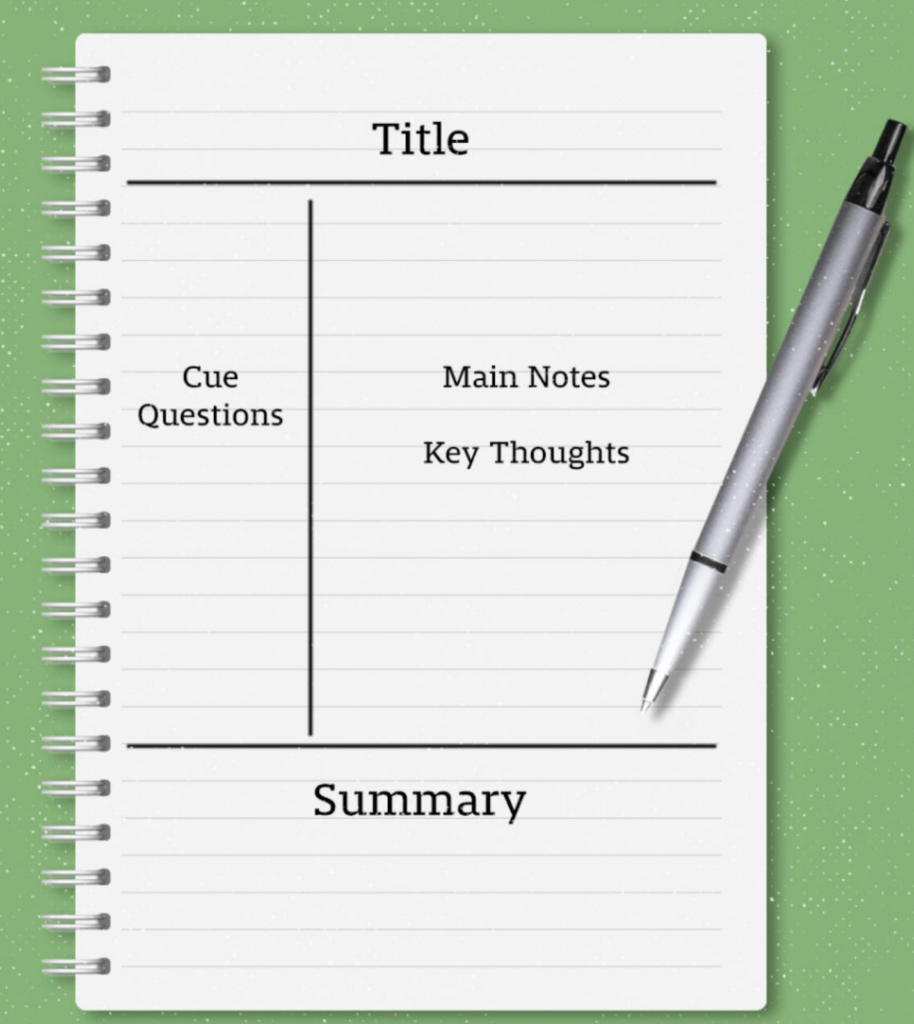
Divide the page vertically into two sections, one slim and one wider. Write bulleted notes in the wider column and main points in the slim column. Write a summary of the meeting after you’ve written everything down.
Capture Immediate Context
Whether you take notes manually or use some software, context is everything.
How you see notes, how you re-use, and how you share them with others can be heavily influenced based on the context they were taken in.
Let’s say you took notes during a meeting that discussed the new website of your company. You wrote down some ideas from brainstorming, how the website should look, and what functionality might be required.
A week later someone on your team asked you to share the notes. Can you answer these questions:
- What was the meeting goal?
- Who were the participants?
- When was the meeting held (before something, after something, during some project)
Yes, you discussed the website, but were you discussing it with developers or marketers? Was the goal to discuss new features or establish a roadmap? Should you schedule a follow-up meeting with developers or designers?
Note: even a few words about context, however obvious they seem at a time, make all the difference when you review the notes a few months later. People forget the “why” quickly. A simple “taken after we wrapped up project X” note will instantly provide more insight into the notes you took.
By using the questions mentioned above, you can quickly capture the context of your meeting notes. Providing context becomes especially crucial when you’re organizing notes from multiple meetings that are related to each other.
Organize Your Meeting Notes
You can increase the value of your meeting notes tenfold by properly organizing them.
After all, we don’t take meetings for the sake of it. When your meeting notes are organized, you can:
- Quickly search through past notes
- See related notes from different meetings and arrive at new insights
- Provide context for future meetings
- Save time by not taking similar notes over and over
There are different ways of organizing your meeting notes. Let’s explore the most simple and productive.
Tags
Virtually any software that allows you to save notes supports tags in one way or another.
And if you tag your meeting notes, you can quickly browse through notes that contain the same tags.
Let’s say you store meeting notes in Slack. For example, you had a meeting that discussed new onboarding policies and typed down some ideas. Simply write #onboarding next to your notes.
Type #onboarding in Slack search and you can see all the messages related to onboarding with a similar tag.
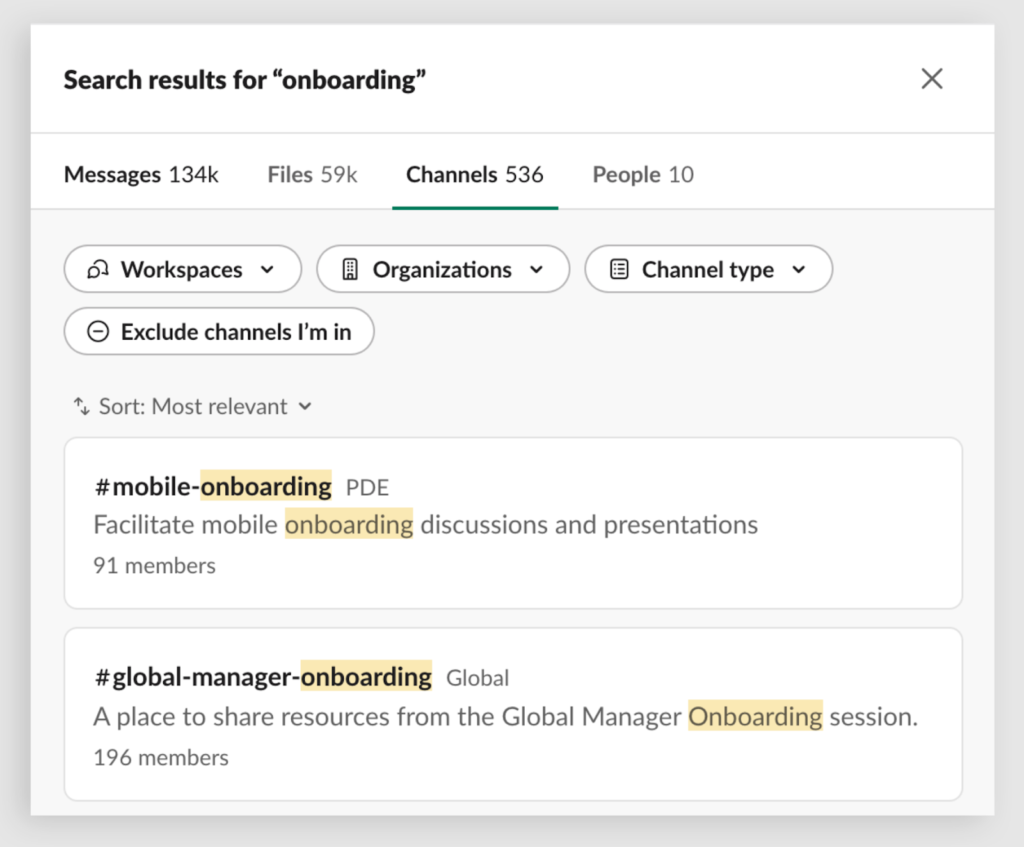
If you take meeting notes by hand, you can use colored stickers and labels. The idea is similar: you use color and written labels to tag similar notes so that you can quickly find related notes in your notepad.
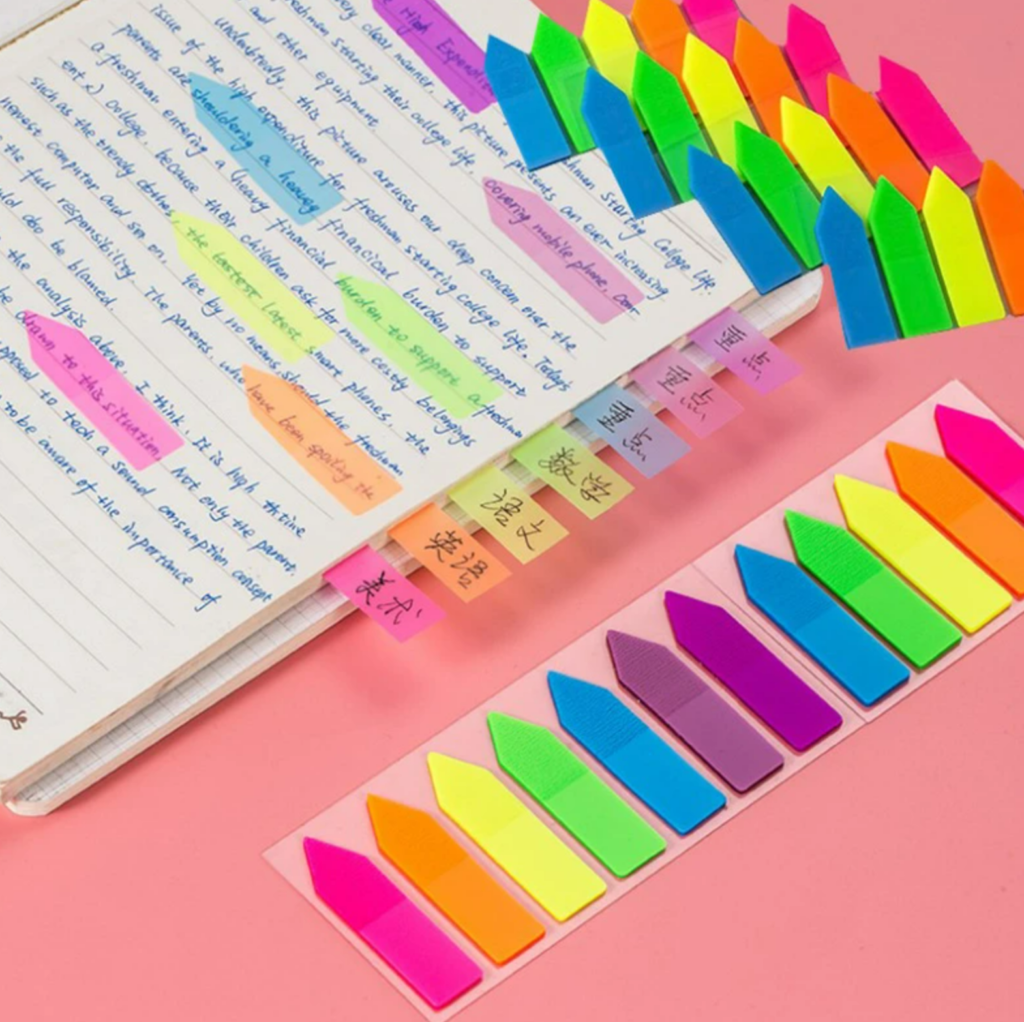
Bi-Directional links
Bi-directional links are only available when you are using digital software for storing notes. Using tools such as Notion, Roam Research, or Obsidian, you can create two-way links between all the meeting notes you have.
Here’s how it works. Let’s say you took some notes during a meeting about onboarding. Within these notes, you also mentioned notes from that other meeting when you discussed a new company intranet.
You can link notes from onboarding meetings with company intranet notes by using a @ prefix in Notion:
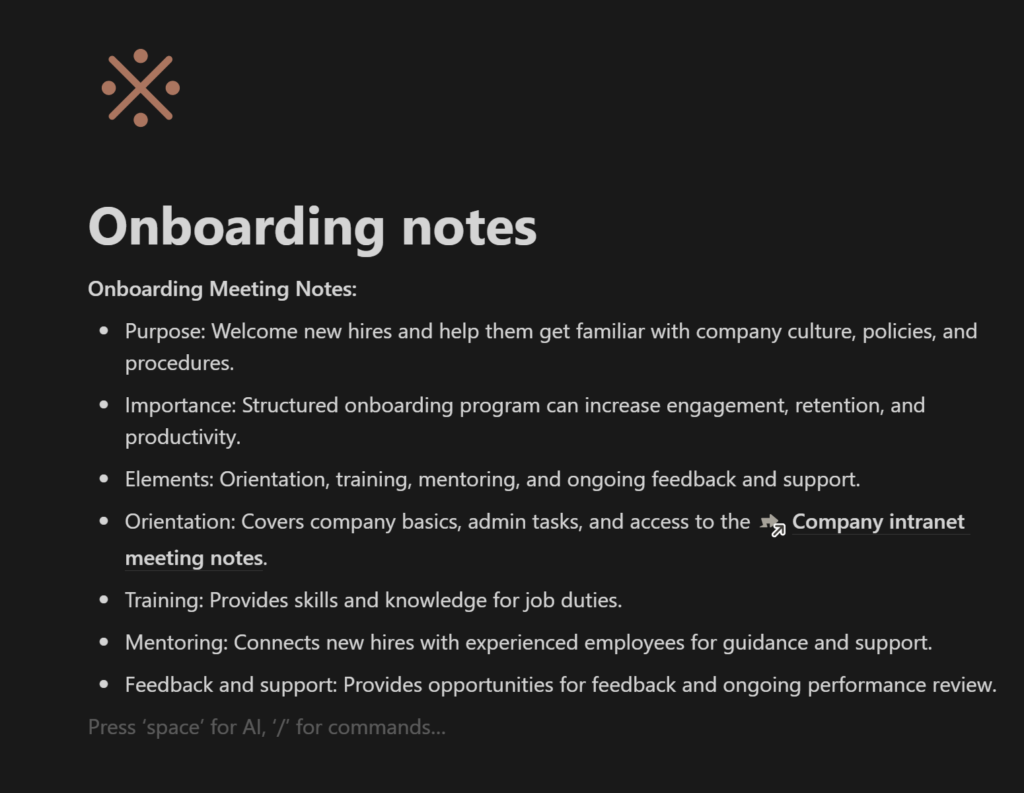
But the best part (and why bi-directional links are so powerful) is that when you link your notes, you can see all the pages with notes that are linking to the current note:

If you use bi-directional links to link your notes long enough, you’ll start creating powerful connections between your notes, forming entire knowledge bases where all your notes are interconnected.
Folders
Folders are the easiest and most basic way to organize your notes. For example, you can use Dropbox or Google Drive to create folders for separate projects and then populate them with relevant notes.
Or, if you’re using pen and paper, organize your notes into different folders and notebooks.
Hint: the three mentioned organization systems (tags, links, and folders) can be combined to create a sophisticated note database with all the notes from your meetings in one place.
For example, you can use bi-directional links and tags in Notion to organize comprehensive, yet easy-to-use note databases with all the valuable information from your meeting in one place.
Add Action Items
When taking meeting notes we often lack focus. How do we use these notes in the future? Are we even going to use them at some point?
Turning meeting notes into action items helps you take a more focused approach to how you take notes during a meeting.
Rather than randomly recording thoughts on paper or elsewhere, treat every idea that you are about to write down as either an action or a required context for some action. Divide your notebook into two areas: write actions on the left, and the right part will store the context and ideas for these actions.

For example, if you are in a meeting about a new marketing campaign, and you discuss promising marketing channels, write down an action “launch new marketing campaign” on the left, and to the right add every idea relevant to that goal.
You can always adjust and rewrite actions later. The main idea here is to put you into an action mindset. Lots of meetings are unproductive because they don’t lead to anything. If you notice you lack action items at the end of the meeting, it might be time to reevaluate the purpose of your meetings.
Use Meeting Templates
Templates help you structure your meeting notes before the meeting even starts.
This, in turn, helps you take meeting notes faster and in a more organized manner.
Many services offer ready-to-use meeting notes templates that you can simply download and print or use digitally. The action items template above is an example of a template put to use.
Note: you can create your own templates and re-use them as well.
Possible templates for meeting notes include:
- Agenda-based template. If your meeting has a clear agenda, you can structure your meeting notes according to it.
- Topical template. If there are several topics that you are planning to discuss during a meeting, but you don’t have a clear agenda on how simply organize your topics by note. Topics can be combined with an action-based template so that each topic in notes is wrapped up with action items.
- Downloadable template. Many services such as Canva offer ready-to-use templates for meeting minutes. Simply download one and fill it out during the meeting.
Hint: Save time and bring out the best in your meetings with Geekbot Meeting Templates!
Run Asynchronous Meetings
If your team communicates in Slack or MS Teams and has recurring meetings such as daily standups, 1-on-1s, and retrospectives, these meetings can be run asynchronously, i.e. not in real-time, and directly in Slack or MS Teams.
Asynchronous meetings save dozens of hours each week, as well as allow for a very efficient way of taking notes.
Let’s say you want to run a daily stand-up to learn what everyone is doing and will be doing.
Here’s how it works asynchronously in Slack. (we’ll use the free Geekbot to demonstrate this.)
First, Geekbot sends daily standup questions to every meeting participant via a direct message:
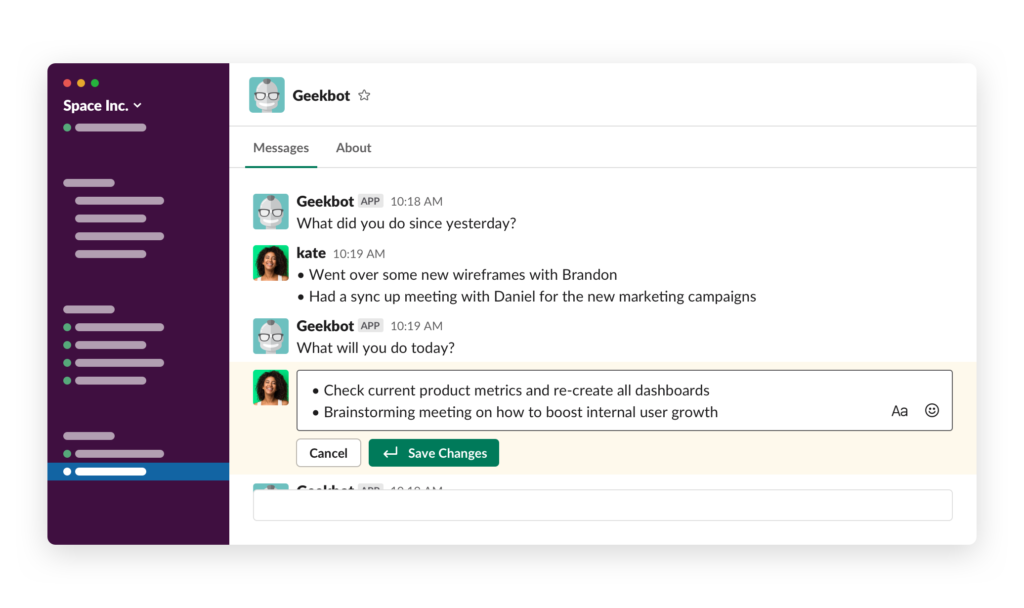
Everyone can answer questions whenever they can, and Geekbot will simply gather all responses in a designated Slack channel:
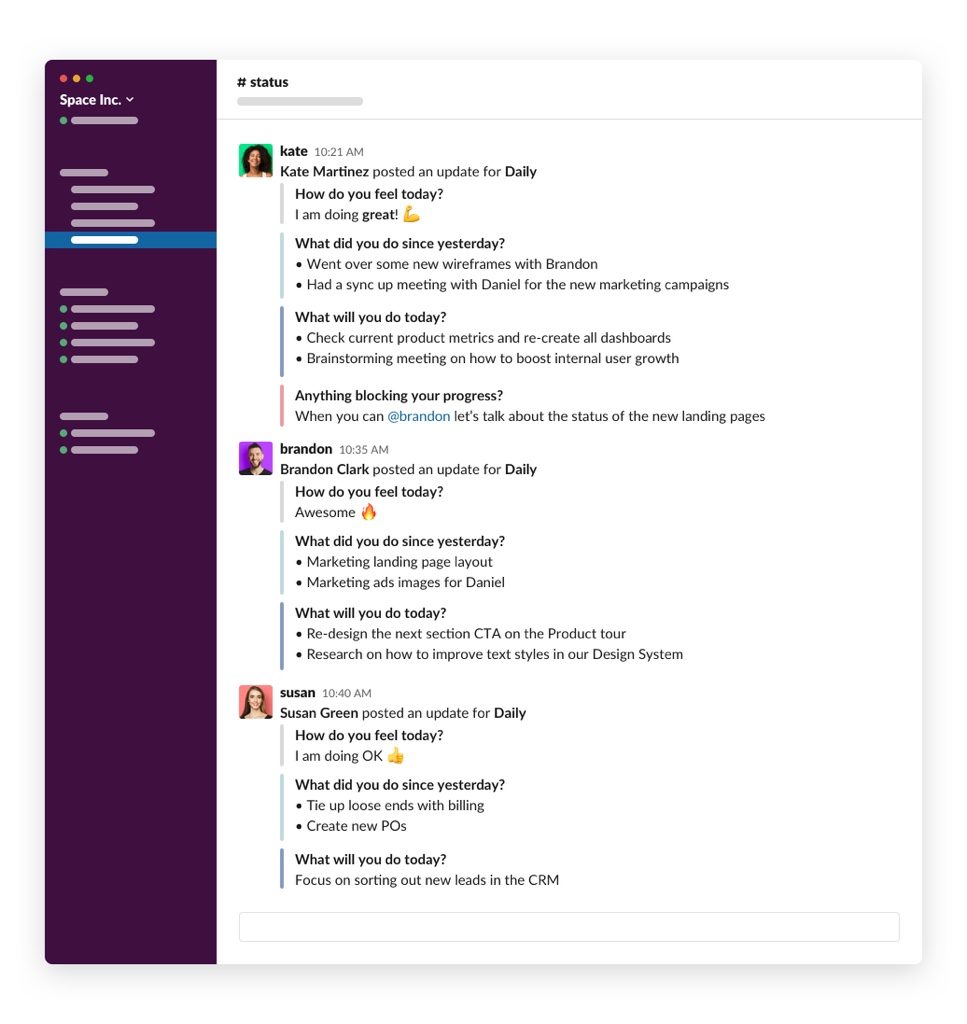
And that’s it. There are your meeting notes. You don’t even need to take meeting notes separately as every team member already provided the most concise version of their input.
In addition to that, Geekbot has a specific meeting notes preset that can be launched after any other meeting. The idea is simple: you participate in your meeting as usual without taking any notes during the meeting to avoid distraction. As soon as the meeting ends, Gekbot will ask you to provide some notes while they are still fresh in your memory.
Geekbot will then saves your notes whenever you want.
There are two advantages of this approach compared to taking notes during your meetings.
First, you can fully immerse yourself in your meeting without thinking of how to take notes during that meeting. Second, all your meeting notes will be stored in Slack (or MS Teams) and can be searched using tags and searches. You can also edit your notes over time and add new information using Slack’s built-in thread system.

Take Meeting Notes By Hand Or Using Software?
You can take notes using pen and paper. You can type your meeting notes into a digital notepad. Or you can use AI tools that will automatically transcribe and summarize your meeting notes.
Although how you take meeting notes comes down to personal preference, taking notes using digital tools has several advantages that traditional pen and notepad note-taking systems don’t offer:
- Easy to share meeting notes. When your notes are digital it’s easy to copy and paste them between different digital tools or share them with your colleagues remotely.
- Easy to build connections between meeting notes and search within them. When your notes are digital, it’s easy to link notes between each other, tag them and quickly search through your past notes if you want to find something specific.
- Can use advanced AI tools to work with notes. When your notes are digital, you can use AI tools to summarize your notes, expand your notes, translate your notes into different languages, or edit your notes.
When to Take Notes: During or After The Meeting?
Again, there’s a trade-off between taking notes during or after the meeting.
If you take notes during the meeting, your notes are more detailed and complete as you take them on the go. However, the depth comes at the expense of engagement as you spend lots of mental focus to frame ideas into notes and then write them down.
When you take notes after the meeting, you lose details as it becomes impossible to remember every nuance that was discussed during the meeting. However, you can fully immerse yourself into the meeting without spending effort on taking notes. Additionally, you gain a bird-eye view of a meeting and are forced to write down only what’s important.
Common Mistakes When Taking Meeting Notes
- Trying to write down everything. Trying to write down everything that was said during a meeting is both futile and exhausting. Focus only on the most crucial parts of the discussion.
- Lack of context. Without a necessary context, your notes can lack either actionability or detail to be useful. A context includes participants, purpose, decisions, and how these decisions were made.
- Poor note organization. If your notes are spread all over the place, it can become too hard to make sense of them.
- Adding personal opinions and comments. Your notes are infinitely more useful when they can be easily shared with other teammates. Make sure your notes stay neutral otherwise you will be hesitant to share them with your group.
- Using new templates every time. It’s best to arrive at a few proven formats for taking meeting minutes and stick to them. You will be more and more comfortable and productive when using the same formats, plus it’s easier to exchange meeting minutes with colleagues who are using the same formats.
Taking effective and efficient meeting notes is an essential skill that can greatly impact productivity and communication within a team. By employing various methods and tools, such as asynchronous meetings, templates, AI tools, and smart formatting, you can greatly enhance your note-taking abilities. Remember to focus on key points, prioritize clarity and conciseness, and review your notes promptly.
Frequently asked questions
What should I focus on when taking meeting notes?
Focus on the key points discussed, such as objectives, decisions made, action items, and important dates. It's essential to capture the essence of discussions without getting bogged down in excessive detail. Be sure to note participants' names for future reference and to provide context.
How can I organize my meeting notes effectively?
Organize your notes by using headings, bullet points, and numbered lists. Categorize information under relevant topics, and prioritize important points. Consider using templates or digital tools that can help streamline the note-taking process and improve overall organization.
How can I ensure my meeting notes are clear and concise?
Use simple, clear language, and avoid jargon when possible. Abbreviations and symbols can help save time, but ensure they're easily understood. Review and edit your notes promptly after the meeting to clarify any unclear points and remove unnecessary information, ensuring they remain accurate and useful.



